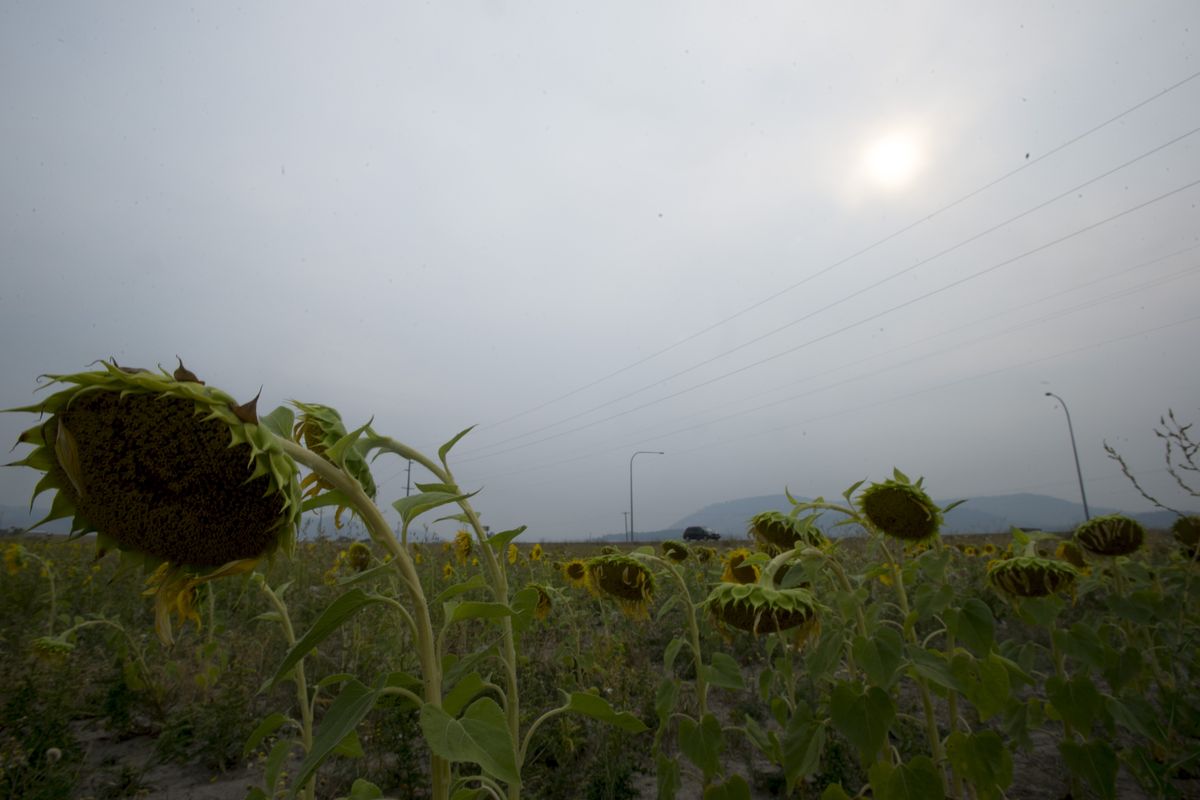Spokane’s searing summer sets records for heat, dry
The late afternoon sun beats down on sunflowers on Monday near Chewelah, Wash. The Inland Northwest has been under a severe drought this year, along with most of the West. (Tyler Tjomsland)Buy a print of this photo
The summer of 2015 will be the hottest and driest ever in Spokane.
The National Weather Service on Monday said the period from June 1 to Aug. 24 is by far the driest, with only 0.3 of an inch of rainfall at Spokane International Airport. The previous record in 1949 was 0.41 of an inch.
As for temperature, the average this year of 73 degrees shatters the 1922 record of 71.1 degrees for the same period.
The U.S. Drought Monitor, which tracks drought conditions nationally, shows Eastern Washington, North Idaho and the east side of the Cascades in an extreme drought.
The rest of Washington is in the next-lowest category of severe drought.
“Warmer-than-normal temperatures and large precipitation deficits continued to hold their grip on Washington and Oregon,” the drought monitor reported last week.
The drought monitor is a cooperative project of the University of Nebraska-Lincoln and federal agencies.
The lack of moisture combined with dry thunderstorms and winds have accelerated wildfire problems.
Ron Miller, forecaster for the weather service in Spokane, said a poor winter snowpack combined with record June heat led to the tinder-dry conditions.
“June really pushed this to another level,” Miller said.
June was the warmest June on record with an average temperature of 71.4 degrees, which was 9.3 degrees above normal.
The average daily temperature is derived from combining daytime highs and nighttime lows.
Dangerous fire weather is forecast to continue this week.
Fire officials report that fires are behaving more unpredictably due to the dryness. Spot fires, in which burning fuel travels through the air to set new fires, are occurring at greater distances from their original fires, officials said.
Because the landscape is so dry, it is easier for a dying ember to start a new spot fire, Miller said.
This year’s drought is the worst since 1976 and 1977 and possibly longer, he said.
Massive fires in 1910 in Idaho, Washington and Montana came during a similarly dry and hot period and blackened 3 million acres. However, heavy snows occurred the winter before the fire.
Last week, the weather service staff in Spokane issued an executive weather summary to support Washington state’s effort to gain a federal disaster declaration due to wildfires.
The summary said the seeds of drought started during 2013 and 2014, when normally wet months were drier than normal.
So far this year, some locales east of the Cascades have received as little as half of the normal precipitation.
Not surprisingly, the driest areas roughly coincide with the locations of the worst fires, including parts of Chelan and Okanogan counties.
Wenatchee has had triple-digit heat on 18 days this season. Omak has seen similarly hot weather.
Numerous fires were triggered on Aug. 13 and 14 when more than 250 lightning strikes were detected.
“A dry cold front moved across the area later on the 14th and this resulted in significant winds and rapid fire growth on many of the fires,” the weather summary said.
The large burn scars being left by this year’s fires will pose new risks once rains return. Mud and debris flows are possible in those areas. The risk typically lasts up to five years after a fire, the report said.
Across the region, the drought is creating hardships for agriculture and wildlife.
The Washington Department of Fish and Wildlife has ordered emergency fishing restrictions and closures on numerous rivers to protect sensitive stocks from harm in the warm, low waters.
A die-off of sockeye salmon earlier this summer was blamed in part on warm Columbia River water.
The Walla Walla River went dry earlier this season when firefighters pulled large amounts of water to fight the Blue Creek fire nearby. It was flowing at barely a trickle Monday at Touchet, Washington.
Fish managers are working with the Department of Ecology to get more water into streams. Officials plan to trap steelhead trout and haul them upstream to cooler waters on the Walla Walla River.
Wheat kernels from dryland farms are smaller than usual this summer because of the lack of rainfall.
Hay growers also are reporting losses.
Irrigation water is being limited to some growers.
Hector Castro, communications director for the state Department of Agriculture, said officials initially estimated that drought would cost $1.2 billion in agricultural losses, but that was before the triple-digit heat arrived in June.
“Some crops are very stressed,” he said.

